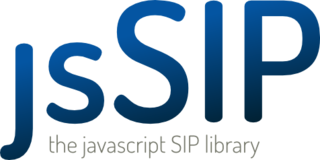The Session Initiation Protocol (SIP) is a signaling protocol used for initiating, maintaining, and terminating communication sessions that include voice, video and messaging applications. SIP is used in Internet telephony, in private IP telephone systems, as well as mobile phone calling over LTE (VoLTE).
Voice over Internet Protocol (VoIP), also called IP telephony, is a method and group of technologies for the delivery of voice communications and multimedia sessions over Internet Protocol (IP) networks, such as the Internet. The terms Internet telephony, broadband telephony, and broadband phone service specifically refer to the provisioning of communications services over the Internet, rather than via the public switched telephone network (PSTN), also known as plain old telephone service (POTS).
The IP Multimedia Subsystem or IP Multimedia Core Network Subsystem (IMS) is a standardised architectural framework for delivering IP multimedia services. Historically, mobile phones have provided voice call services over a circuit-switched-style network, rather than strictly over an IP packet-switched network. Alternative methods of delivering voice (VoIP) or other multimedia services have become available on smartphones, but they have not become standardized across the industry. IMS is an architectural framework that provides such standardization.
A session border controller (SBC) is a network element deployed to protect SIP based voice over Internet Protocol (VoIP) networks.

Skype for Business Server is real-time communications server software that provides the infrastructure for enterprise instant messaging, presence, VoIP, ad hoc and structured conferences and PSTN connectivity through a third-party gateway or SIP trunk. These features are available within an organization, between organizations and with external users on the public internet or standard phones.

A VoIP phone or IP phone uses voice over IP technologies for placing and transmitting telephone calls over an IP network, such as the Internet. This is in contrast to a standard phone which uses the traditional public switched telephone network (PSTN).
QuteCom was a free-software SIP-compliant VoIP client developed by the QuteCom community under the GPL-2.0-or-later license. It allows users to speak to other users of SIP-compliant VoIP software at no cost. It also allows users to call landlines and cell phones, send SMS and make video calls. None of these functions are tied to a particular provider, allowing users to choose among any SIP provider.
VoIP User was a community-driven and financed SIP based VoIP network. The projects aim is to introduce people to the concept of VoIP by allowing members to experiment with SIP and IAX2 devices
This is a comparison of voice over IP (VoIP) software used to conduct telephone-like voice conversations across Internet Protocol (IP) based networks. For residential markets, voice over IP phone service is often cheaper than traditional public switched telephone network (PSTN) service and can remove geographic restrictions to telephone numbers, e.g., have a PSTN phone number in a New York area code ring in Tokyo.
Mobile VoIP or simply mVoIP is an extension of mobility to a voice over IP network. Two types of communication are generally supported: cordless telephones using DECT or PCS protocols for short range or campus communications where all base stations are linked into the same LAN, and wider area communications using 3G or 4G protocols.
FreeSWITCH is a free and open-source telephony software for real-time communication protocols using audio, video, text and other forms of media. The software has applications in WebRTC, voice over Internet Protocol (VoIP), video transcoding, Multipoint Control Unit (MCU) functionality and supports Session Initiation Protocol (SIP) features.

H.323 is a recommendation from the ITU Telecommunication Standardization Sector (ITU-T) that defines the protocols to provide audio-visual communication sessions on any packet network. The H.323 standard addresses call signaling and control, multimedia transport and control, and bandwidth control for point-to-point and multi-point conferences.

Jitsi is a collection of free and open-source multiplatform voice (VoIP), video conferencing and instant messaging applications for the web platform, Windows, Linux, macOS, iOS and Android. The Jitsi project began with the Jitsi Desktop. With the growth of WebRTC, the project team focus shifted to the Jitsi Videobridge for allowing web-based multi-party video calling. Later the team added Jitsi Meet, a full video conferencing application that includes web, Android, and iOS clients. Jitsi also operates meet.jit.si, a version of Jitsi Meet hosted by Jitsi for free community use. Other projects include: Jigasi, lib-jitsi-meet, Jidesha, and Jitsi.
WebRTC is a free and open-source project providing web browsers and mobile applications with real-time communication (RTC) via application programming interfaces (APIs). It allows audio and video communication to work inside web pages by allowing direct peer-to-peer communication, eliminating the need to install plugins or download native apps. Supported by Apple, Google, Microsoft, Mozilla, and Opera, WebRTC specifications have been published by the World Wide Web Consortium (W3C) and the Internet Engineering Task Force (IETF).
Acrobits is a privately owned software development company creating VoIP Clients for mobile platforms, based in Prague, Czech Republic.
Ingate Systems AB is a Swedish company that sells data network security and telecommunication equipment. The company primarily provides SIP Trunking of IP PBX:s on the US market. It is associated with sister company Intertex Data AB.

JsSIP is a library for the programming language JavaScript. It takes advantage of SIP and WebRTC to provide a fully featured SIP endpoint in any website. JsSIP allows any website to get real-time communication features using audio and video. It makes it possible to build SIP user agents that send and receive audio and video calls as well as and text messages.
ipDTL is an IP codec running in a web browser, used for remote broadcasts in television, radio, and voice-over. It is a replacement and compatible with older ISDN audio codecs. Then, it is also capable of video transmissions and can be used in the field with some mobile devices.
Web Call Server is unified intermedia server software developed by Flashphoner. It is a server-side platform, implemented in Java, dedicated for streaming video over wide range of communication protocols, including:






